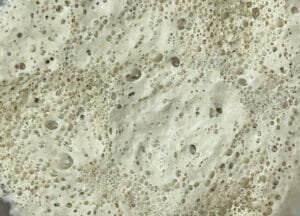Want to bake crusty Italian bread at home that rivals your favorite bakery? The secret is in the Biga starter, it’s not some mystical baking art, and it’s super easy. In just a few simple steps, you’ll be on your way to baking perfect loaves that will make your kitchen smell like an artisan Italian bakery. So roll up your sleeves, grab your apron, and let’s make a classic Italian recipe in just 3 easy steps, perfect for both bread and Italian pizza styles. But first, let’s take a look at what is biga and how it differs from Poolish and sourdough starter and much more.

What is Biga?
Biga is a type of preferment commonly used in artisan Italian breads. Unlike other types, biga is not a natural starter and is usually made fresh daily with high protein flour, water and commercial yeast with a hydration level between 40 and 80%. The Italian Biga is left to ferment for several hours (between 6 and 72 hours) depending on the baker’s preference and room temperature. This short fermentation has a big impact on the final product, as it adds depth and complexity to the flavor, a slightly nutty taste, and a chewier texture with a large holes structure.
What is the Difference between Biga and Poolish?
Both are popular preferments options that contain the same ingredients but have different hydration levels and different effects on the final product result. Biga dough is drier and stiffer, resulting in a slightly tighter crumb with fewer large holes, while Poolish has more moisture, making it more elastic and suitable for breads with a light, open crumb texture. Another distinction between them is that Biga starter is only made with strong wheat flour to improve the dough’s ability to develop structure and add shelf life to the dough, while Poolish can be made with other types of flour, resulting in a shorter shelf life as it must be consumed within 24 hours.
| Biga | Poolish |
|---|---|
| Italian | Polish |
| Made with bread flour only | Can be made with any flour type |
| Allow to ferment for 6-72hours | Allow to ferment for 6-18hours |
| 40-80% hydration level | 100% hydration level |

What is the Difference between Biga and Sourdough Starter?
The main difference between biga and sourdough starter is their composition and purpose in bread making. Biga is made from yeast, flour, and water and is commonly used in Italian breads such as ciabatta and focaccia, as well as pizza dough. In contrast, sourdough starter is made from a mixture of flour and water fermented with wild yeast and lactic acid bacteria, making it commonly used in artisan breads like sourdough loaves.
| Biga | Sourdough starter |
|---|---|
| A preferment | A preferment |
| Made with flour, yeast and water | Made with flour and water |
| Made and used only once | Regularly refreshed, can be used for years |
| Used for Italian bread and pizza | Used for artisanal bread |
How Long Can Biga Last In the Fridge?
Biga can be stored in the refrigerator for up to 5 days, but remember to take it out 30 minutes before kneading. If you want to store it for longer, you can freeze your preferment for up to three months, but you’ll need to take it out three hours before kneading to activate it again.
Can I Turn This Recipe into Pizza Biga Dough?
Absolutely, you can adapt this biga recipe for pizza dough, but there are some differences to keep in mind. Bread biga is more dense than pizza biga, but you still use it to make Neapolitan pizza. However, if you want to transform this biga recipe into a pizza biga, simply add 20-30% more water (based on flour weight). This will create a more bubbly preferment similar to poolish that will result in a lighter, airier crust with irregular crumbs, perfect for pizza.
What the Percentage of Biga is Used in Bread and Pizza?
It’s a baker’s choice and can vary depending on the recipe and desired characteristics of the final bread, some Italian bakers may make breads using 100% biga dough. However, most bakers use between 20% and 80% of the weight of the flour in the final dough.

Easy Italian biga starter recipe
Ingredients
- 1 cup Bread Flour
- ½ cup Water
- 1 tsp Fresh Yeast (or ⅓ tsp dry yeast)
Instructions
- In a food container, add the bread flour and fresh yeast (Rub the yeast with your hand into the flour to make sure it is well distributed when mixing the biga dough), pour the water, and close the food container with the lid.
- Gently rotate the container from left to right for 2 to 3 minutes, as if you were shaking it (Don't over-rotate it so it doesn't form a dough).
- Open the food container (At this moment you can see the little balls of biga dough that you have successfully made), and clean the sticky paste on the edges and corners, then close the container and place it at room temperature for 1 hour, then refrigerate for 23 hours.
- After 24 hours, the Biga Starter is ready to use and you can start making your favorite Italian breads and pizzas.

